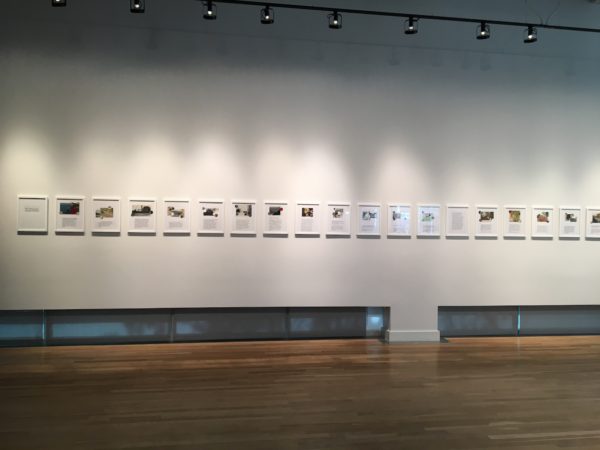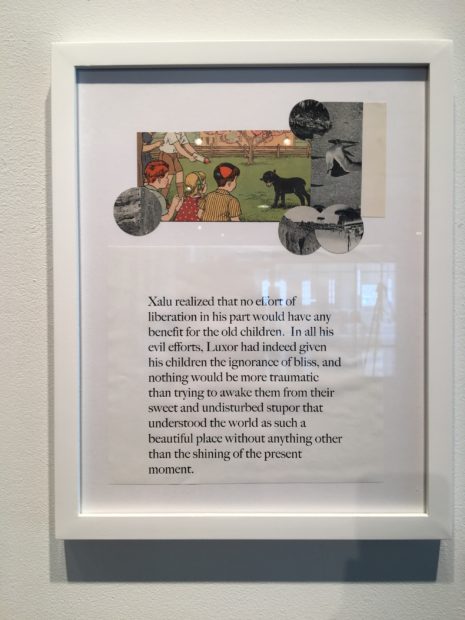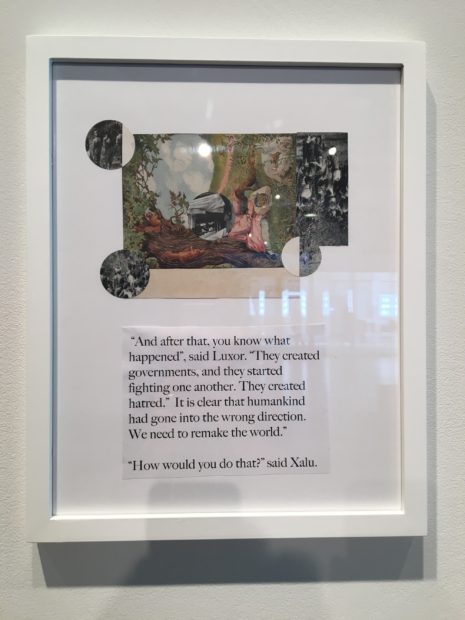
Pablo Helguera’s exhibition The Fable Is To Be Retold at DiverseWorks in Houston is not very visually interesting. But it’s not really meant to be. Consisting of collages, videos and an interactive installation in an Ames room, the purpose of the show is primarily didactic. It’s designed to convey specific political messaging. Helguera is a social practice artist who “combines performance, visual art, community outreach and political activism to examine the social and cultural function of conventional teaching and memory systems.” He’s also the Director of Adult and Academic Programs at the Museum of Modern Art in New York.
Since the 1990’s Helguera has fashioned his artistic career as an extension of his role as a museum administrator. The Administrative Artist, the title of one of his 2003 essays, is an apt description of his view of art as an extension of institutional bureaucracy. In interviews, essays and lectures Helguera consistently rejects the model of the individual artist who makes objects for sale. His pedagogical approach is to teach young artists that instead of self-expression, their primary motivation should be to enact broad social change through an ideology that values institutions over individuals.
I missed the opening-night performances (one of which was recorded in the Ames room and is viewable as a video in the exhibition) but I researched many of Helguera’s past performances online. In The Dictator Game, a hybrid performance-lecture developed for Creative Time’s 2012 annual summit, Helguera offers lessons in several ways a dictator might redistribute wealth. Between each lesson Helguera plays guitar and sings Spanish-language protest ballads against projected text backdrops with slogans like “I love you in mutual disgrace but not in uneven success.” The participants generally seem confused and the social implications of the slogans are pretty creepy.
Formally, Helguera’s collages are aggresssively boring. Cut from textbooks, their texture is uniform. The shapes of the paper are squares, rectangles and perfect circles. There’s hardly a torn edge or a diagonal line to be found. Because the source material comes from mass-produced reproductions in educational material, the color palette is limited and uniform. In the Arlington Heights series the collages are punctuated by enigmatic texts that read as vaguely leftist-progressive. Helguera’s mission is not to trigger intellectual or emotional insight through visual intrigue, but to deliver standardized social messages.

Much of Helguera’s educational and political philosophy is outlined in The Fable of the Ancient Children, a series of twenty collages that stretch across the longest wall in the gallery and read from left to right in the form of a children’s storybook. Here, Helguera tells the story of a brave explorer named Xalu who finds amazing plants, animals and treasures on his travels. Lest we confuse Xalu with a colonialist, Helguera writes that he was not wealthy and gave all of his treasures back to the townspeople in the lands he explored. As a fictional narrative device, one wonders why the townspeople would need Xalu to give their own riches back to them.

Reading Xalu as an allegory of Helguera’s notion of a social practice artist, this apparent inconsistency becomes clearer. During a Q&A after a lecture at the Chicago Art Institute, a student asked Helguera how a social-practice artist can overcome their outsider status when they intervene in communities that are not their own. Helguera’s reply is that artists are always outsiders and as much as they may “want to go and live with them and do the anthropologist thing, you’re never going to be one of them,” [emphasis mine]. My immediate question was, who are these “thems” Helguera is talking about?
If you go to DiverseWorks’ website under their DW Teens program you will see a recently closed application to “provide an opportunity for ten to twelve teens from underrepresented communities to learn about multi-disciplinary art and different professions in the arts.” I suspect Helguera’s “them” usually reside in the “underrepresented” communities referred to in the DiverseWorks project. Helguera’s response to the student’s question perfectly highlights why “socially-engaged” art drives me nuts. Xalu basically reads as a social-practice artist who opens the eyes of the natives to the riches they were too blind to understand were surrounding them all along.
Later in Helguera’s fable Xalu comes to an island called Luz. In the Christian Bible Luz is a Canaanite city in the region of modern-day Israel, Palestine and Jordan where most of the action in the Old Testament takes place. Canaanite is an ethnic term used to describe the indigenous people who were unequivocally slated for genocide by the Hebrew god. On Luz, Xalu finds the children who had long ago been stolen from his hometown by a king named Luxor. Sheltered from the idea of death (Luxor tells them those who die have just gone on a long journey) the children have grown old in an idealized, idyllic ignorance. In one panel Helguera describes Luxor’s theory of why human society has become so unbearable that it requires a benevolent dictator to “remake the world.”

It’s difficult to tell if Luxor’s theory is Helguera’s own, but after watching half a dozen videos of Helguera’s lectures and performances, I’m inclined to think it is. Stripped down, it’s all boiler-plate Marxist theory. For Helguera, reason and the pursuit of truth that led out of feudalism and into capitalism is the source of all hatred and human misery. Ultimately Xalu decides not to “liberate” the grown-up children from their blissful ignorance because he believes it would be too traumatic for them. He opts to leave them in “the shining of the present moment” with their ghosts, monsters and talking animals and under Luxor’s benevolent dictatorship. I read this as Helguera’s assertion that humankind would be better off in a state of primitive mysticism. I couldn’t disagree more.
After reading a handful of Helguera’s bizarre essays, watching several of his near-incoherent lectures to social-practice students about how to effect social change, and digging in to his borderline-fascist fable for kids, I find myself once again dismayed by the state of contemporary art education. Before he was Director of Academics at MoMA Helguera was the head of public programs and education at the Guggenheim for seven years. I believe that, contrary to Helguera and others’ good intentions, the repeated devaluation of the individual artist in favor of some vaguely articulated idea of community is harmful to the overall progressive cause. Unless a community is comprised of aesthetically and politically enlightened individuals, it will be little more than a mob.
Through Nov. 19 at DiverseWorks, Houston.



17 comments
Michael Bise aka Joseph McCarthy
Are those windows at the bottom of the wall? Looks dumb.
Can anyone explain to me why you would think visual art is supposed to be used as a tool for political/social change, and why don’t we hold other art forms up to the same kind of scrutiny? What would it look/sound like if literature or music had to fall on the same Marxist platitudes? Wouldn’t that just be the lefty version of Atlas Shrugged? Don’t get me wrong, that book is fun until it’s not fun anymore. You know what I mean…
political/social change doesn’t = Marxism. And literature/music might look/sound like Strange Fruit, or Night, or Invisible Man, or Blowin’ in the Wind, or I Know Why the Caged Bird Sings, or This Land is Your Land. To name a few.
I take some of the above comments to mean: who says I can’t be an artist doing what I want to do?
The simple (and simple-minded) response is: no one.
Anyway, that’s the wrong question. A better, more interesting question is: what does autonomy mean in art?
Autonomy can refer to a unique way of engaging with the world that suspends the interest and physical needs that characterize our normal orientation to the world.
It can also mean, as is implied in the above article and the subsequent discussion, a convention of the art world which demands that the artist be free of external compulsions as might be forced upon her by religious, political, or moral authorities.
Current art world practices do not resemble the conditions for artists under Stalin in the former USSR, nor artists under Hitler in Nazi Germany. Unless you are a brain in a vat, it is clear that the conditions and possibilities for art in the US now have a strong relationship to the workings of the art media, the institutions of art and those folks running them (whether museums, not-for-profit spaces, and artist-run spaces, coops, collectivities, and guilds), the art market, and every conversation you’ve ever had with friend, foe, teacher, or family about art.
So, what’s wrong about the two definitions of autonomy, above, is:
(1) the first one can’t explain the evolving nature of art practices. As Dylan sings, “you gotta serve somebody”. Not because you are a chattel slave or a wage slave or a being who lacks omnipotence, but because you are a human being living in society. One definition of “society” is a structure of mutual dependence. For “serve” read, “interact”, “recognize”, “respect”, “acknowledge”, etc.
(2) the second definition of autonomy is lacking because it has nothing to say about the basis of art’s communicability. “Communicability” is a vague term, I know. But try to think about it as having less to do with sending a direct message and more to do with the invention and public display of possible ways of making meaning between human beings.
There are other versions of autonomy, too, that are circulating throughout the artworld. One is linked to the French philosopher Ranciere. He says that you can’t approach art already assuming what the outcome of your work will be, what effect it will have, what clear message it will send. An artist puts something out in the world and lets it live a life of its own. That’s this French philosopher’s concept of the liberating nature of art, why it is an act of “freedom” and should remain as such.
I think Bise presses some buttons when he immediately declares the work under consider in his review is not “very visually interesting” and “not meant to be”. This immediately makes Bise complicit with the arguments that art ought to have an aesthetic purpose above all, or at least that is a necessary condition of “interesting” or “good” art. He’s already given up, and I don’t blame people for attacking him and the work he writes about in terms of the work’s alleged political effect or valency.
The trouble with Bise is that he really wants to have it all. And so do those who attack him and support him! Ralph Ellison’s “Invisible Man” is a powerful work of fiction. Can you show evidence linking that work of literature with “political/social change”? Would you have to do to legitimize the claim that it was “beautiful” political art? Or, political art at all?
Marxist platitudes are not the only kind of platitudes swirling around in the above “debate” or characterizing these posted comments in Glasstire. If you don’t make an effort to search out more adequate theoretical resources for talking about what’s in front of you, then where are you? And why should anyone listen to you or read you?
P.S. The notes on autonomy have been shamelessly lifted from the work of Jenny McMahon (University of Adelaide). A philosopher working on aesthetics and also an artist in a previous life . . . I am responsible for the subsequent points in my note.
Yes Michael Corris!
⚡️⚡️⚡️
Fwiw, my own sense is that it is a mistake to read Helguera so simplistically. Social practice does indeed present many interesting theoretical and practical challenges, and it seems quite possible to me that Helguera meant to highlight some of them in order to invite us to consider them with him.
When the artist is just ham-fistedly stating the obvious, social practice art can get annoying really fast. Nobody likes to be condescended to. When it’s really good you don’t even know you’ve been uplifted by it until maybe later.
I think the reviewer is confusing Marxism with Marxist-Lenin material competency. Marxism is it’s true sense is assigning value to labor in a way standard economics cannot.
Is that too pedagogic to say outloud?
Several years ago I had a portfolio review with Luis Camnitzer, famed for conceptual and “message” laden artwork. Alas for me, maker of expressive, colorful, and active abstract painting, I did not know his predilections. After briefly looking at my work, he seemed to cringe, and said “WHY did you make this work? Haven’t you heard that art is now about “communication” not expressiveness!” The moral high ground of social practice art is at strange odds with the value of the very individual that it purports to defend against the institution.
Even with social practice art, the how is of primary importance. The what, though not secondary, is dependent on the way the project is carried out. So without good how, you really have nothing, no matter how compelling the social issue. This is true of all mediums. So for me its not any particular vein in art that might potentially “drive me nuts.” What doesn’t work is any creative product, service, or action that thinks the importance of the what, no matter how compelling, can carry the experience/outcome past bad how.
“When it’s really good you don’t even know you’ve been uplifted by it until maybe later.” — Julie Speed
“Do you still need proof that the story line isn’t what makes a story or a song or a movie bind to your deeper mind?”
— Jeanette Winterson
“When it’s really good you don’t even know you’ve been uplifted by it until maybe later.” — Julie Speed
This is so unbelievably silly. art is great! Before he was Director of Academics at MoMA Helguera was the head of public programs and education at the Guggenheim for one year. Contrary to Helguera and others’ good intentions, the repeated devaluation of the individual artist in favor of some idea of community is good to the overall progressive cause. Unless a community is comprised of aesthetically and politically enlightened..” Yes.
I think the reviewer is confusing Marxism with Marxist-Lenin material competency. Marxism is it’s true sense is assigning value to labor in a way standard economics cannot.
If you want to see some “socialist art” that has a vague mission to bring an aesthetic and social practice to an alternative site, such as a Houston Sharpstown neighborhood, go experience “Sharp”, Havel Ruck Projects new house sculpture (6822 Rowan Lane) Our projects, although not directly social or propogandizing, allows the visitor, either someone who has knowledge of contemporary art issues or just a carpenter or plumber who lives in the neighborhood, to experience it on their own terms. No words or text to read. Just a social experiment to see how the public reacts to such an odd anomaly that mysteriously shows up unexpectedly in their neighborhood. Do we hope to persuade anyone with our social stance that abandoned homes are ripe for artistic action? Maybe, but hopefully we only get them to expand their mind as to what is possible. That’s good enough for me….
Kurt Vonnegut on the political power of art (1973):
“Fiction is harmless. Fiction is so much hot air.
The Vietnam war has proved this. Virtually every American fiction writer was against our participation in that civil war. We all raised hell about the war for years and years—with novels and poems and plays and short stories. We dropped on our complacent society the literary equivalent of a hydrogen bomb.
I will now report to you the power of such a bomb. It has the explosive force of a very large banana-cream pie—a pie two meters in diameter, twenty centimeters thick, and dropped from a height of ten meters or more. “
I’ve got a picture of a cake to post.
I am a former Museum director, gallery director, Board of Directors Chair and now private consultant. I’m a bit late to comment here since I just came across this article. I’ve seen Mr Helguera in action and agree with your general reactions. He seems nice enough – but that’s not sufficient to become a quasi-social worker. Social challenges require sustained commitment and resources; it is more than hit-and-run posturing. I’m not going to delve further into this – however, my contention is that “social practice” is little more that a financial ploy by art schools to generate additional revenue. None of the graduates are armed or licensed to carry out any sort of long-lasting social work or interventions that matter to a community that need such direct services.